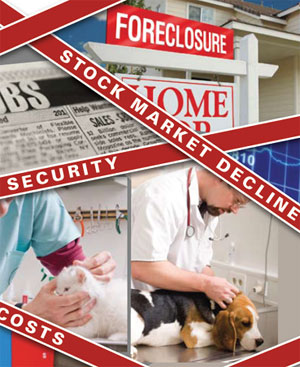Veterinarians keep an eye on the economy

Home foreclosures. Rising fuel prices. Rising food prices. Job losses. Losses in the stock market.
In the current economic climate, small animal practitioners may fear that pet owners have less discretionary income or are less willing to spend on veterinary care. Practices also must account for some of the same cost increases as households.
Although statistics on practice revenues and expenses in 2008 are generally not available yet, veterinarians with expertise in economics believe most small animal practitioners are weathering the slowdown or downturn—varying by community.
"I think there's no question that there's an impact on veterinary practices from the economic issues the country is facing," said Dr. Karen E. Felsted, chief executive officer of the National Commission on Veterinary Economic Issues. "But it's not clear-cut that every practice is feeling the same pinch."
Revenues
Dr. Felsted said veterinarians historically have been fortunate to be in a generally recession-proof industry, and they have done reasonably well when the economy has been weak in the past. She said the impact could be more dramatic this time, however. Many practices have seen slower growth, while others have seen declining revenues—particularly in regions where the housing crisis has hit hardest, such as parts of Florida and California.
Dr. John W. Albers, executive director of the American Animal Hospital Association, said the economy also has had an impact on practices in metropolitan areas with high unemployment, such as Cleveland and Detroit. Other practices report that revenues are fluctuating from month to month.
I think there's no question that there's an impact on veterinary practices from the economic issues the country is facing. But it's not clear-cut that every practice is feeling the same pinch.
— Dr. Karen E. Felsted, Chief Executive Officer, National Commission on Veterinary Economic Issues
"We don't have anything other than anecdotal data," Dr. Albers said. "But what we hear is, for the most part, veterinary practices are doing fairly well. Some report that their practice growth has slowed down some."
He added, "Now's the time to think about providing very high-level service to all your clients."
Veterinarians also should concentrate on reminding clients about what's essential to keep pets healthy, Dr. Albers said.
"I think there is still opportunity," said Dr. Christine Merle, a consultant with Brakke Consulting and immediate past president of the Association for Veterinary Practice Management Consultants and Advisors. "People will spend the money if they find value in what you're offering and the essential need for it."
Dr. Merle said pet owners will pay for urgent care and medications, but some may delay or reconsider preventive procedures such as vaccinations and dental cleanings. Therefore, veterinarians should educate clients about the need for preventive care.
Dr. Felsted of the NCVEI agreed that it is more important than ever for veterinarians to communicate the value of their services by talking with clients about the benefits of recommended procedures. If clients haven't lost their homes or jobs, she said, they still have discretionary income for necessary veterinary care—but they need to perceive veterinary care as more important than other choices.
For good clients who fall on tough times, Dr. Felsted said, veterinarians might find themselves more often working out payment plans or helping choose medically appropriate treatment alternatives that aren't as expensive as the procedures they would normally recommend.
Expenses
Because veterinarians' expenses are rising just like everyone else's, Dr. Felsted doesn't recommend a general reduction in fees. Practices are going to need to consider continuing to increase their own fees at least to cover their rising costs, she said.
Costs are always increasing in veterinary practices—but some expenses, such as pet food, are now increasing more rapidly. High gasoline prices have a direct effect on practices with an ambulatory component, but fuel prices exert inflationary pressure on other costs as well.
"Transportation costs are part of everything that we buy and every service that we use," Dr. Felsted said.
Veterinarians should focus on cutting any fat out of their operations, she said. Practices can't afford not to be efficient, particularly with inventory and staffing.
"There is no better time to focus on improving how you run your business, on improving your business skills," Dr. Felsted said. "An increase in practice profitability will go a long way toward counteracting the effects of lower revenues."
Dr. Albers of AAHA agreed that rising expenses mean now is not the time for reducing fees. He said, "In general, inflation is up, and that impacts just about everything the veterinary practices do."
Dr. Merle of Brakke recommends that practices package orders for supplies into fewer shipments to save on delivery charges. Veterinarians might reconsider where they and their staff travel to meetings for continuing education. Small animal practitioners who operate mobile units or provide at-home care can plan their schedules to minimize fuel costs and make sure to charge appropriately for travel.
Another reason that veterinarians shouldn't discount fees is because they may not be able to maintain the reductions, Dr. Merle added.
"The reality is you may get somebody in the door this time, but they're going to have that expectation of a lower price six months down the road," she said.
Dr. Merle said veterinarians should remain aware of the current economic situation nationally and locally, but they also should think about the years to come.
"They need to stress that long-term vision, not short-term reactions," she said.